Despite all the built-in functions provided by Excel, we may need to create a different function to get our job done. Excel lets us create our own functions by using VBA Programming Code. In this article, we will provide a step-by-step methodology to create a custom formula in Excel.
Watch the Video – Create a Custom Formula in Excel
What Is a User Defined Function?
Excel allows us to create our own custom functions using VBA code, known as User Defined Functions (UDF). Let’s create one.
Suppose we have the Price List for Items in ABC Store as our dataset. In the dataset, we have the Stock amount and Unit Price of Items in the store. We’ll create a custom function to calculate the Total Prices.
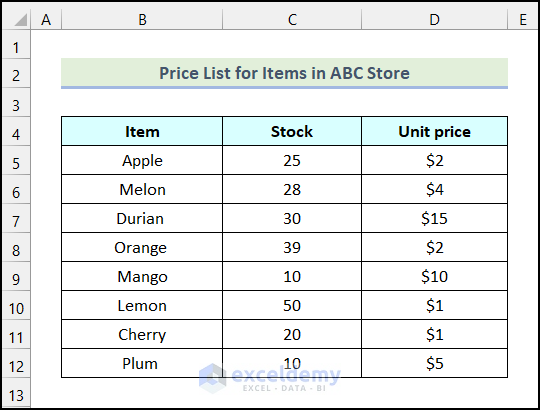
Example 1 – Creating a Custom Formula to Find the Total Price in Excel
In order to write the VBA code to create a customized formula, we need to open the VBA window.
Step 1 – Enable the Developer Tab
- Click on the Customized Quick Access Toolbar.
- From the drop-down, click on the More Commands option.
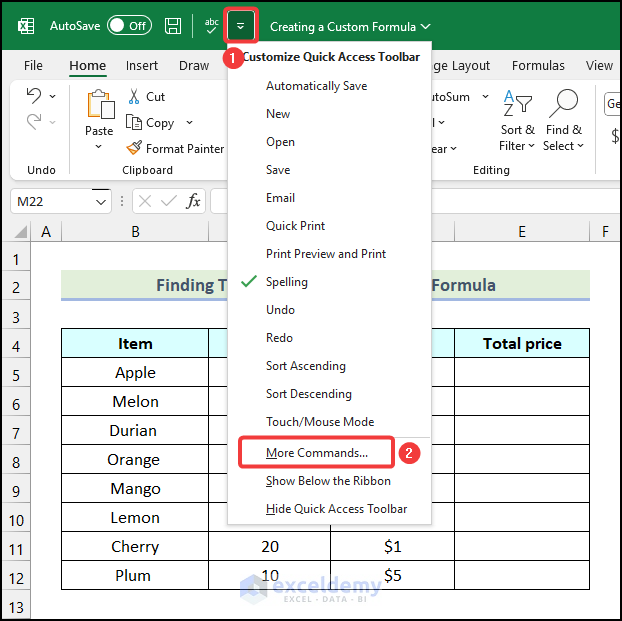
The Excel Options dialog box will appear.
- In the Excel Options dialog box, go to the Customize Ribbon tab.
- Check the box of the Developer field.
- Click OK.
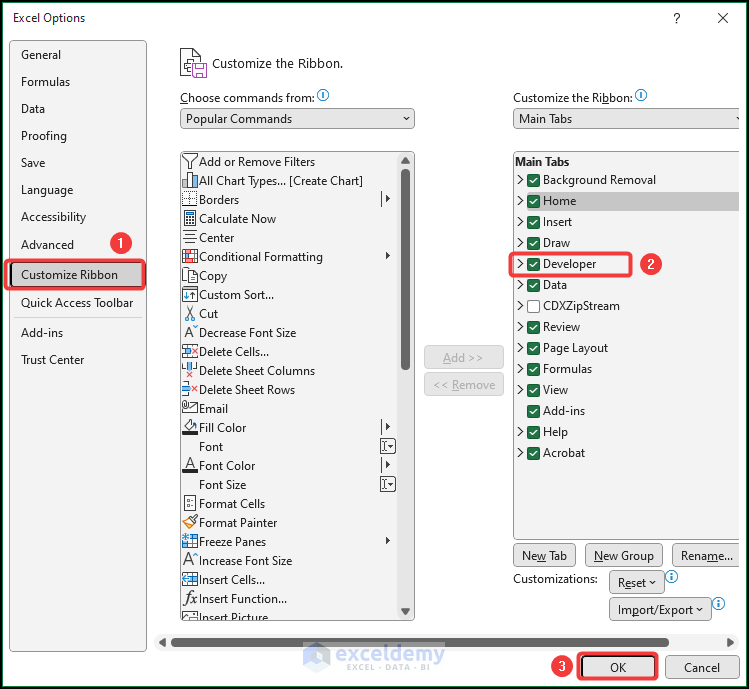
As a result, the Developer tab will be available in the Ribbon, as shown in the following image.
- Go to the Developer tab.
- Click on the Visual Basic option from the Code group.
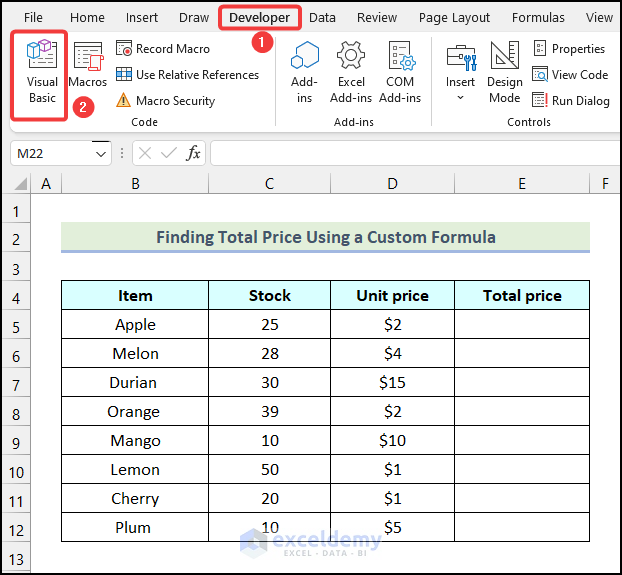
Step 2 – Write VBA Code to Create the Custom Formula
We are all set to write VBA code to create the custom formula.
Steps:
After clicking the Visual Basic option, the Microsoft Visual Basic for Applications window will open on your worksheet.
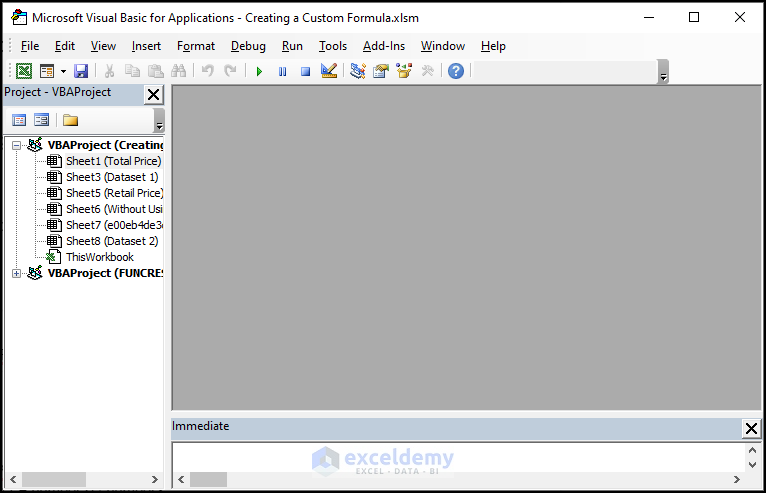
- Go to the Insert tab from the Microsoft Visual Basic for Applications window.
- Choose the Module option.
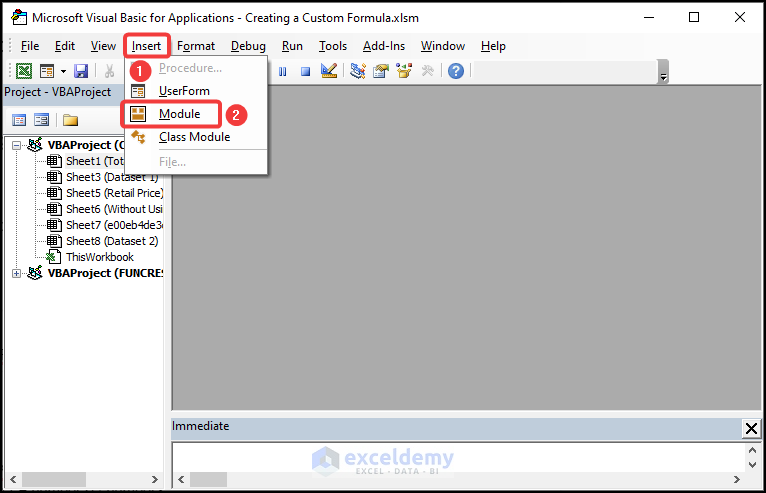
- Enter the following code in the newly created Module;
Public Function TOTALPRICE(number1, number2)
TOTALPRICE = (number1 * number2)
End Function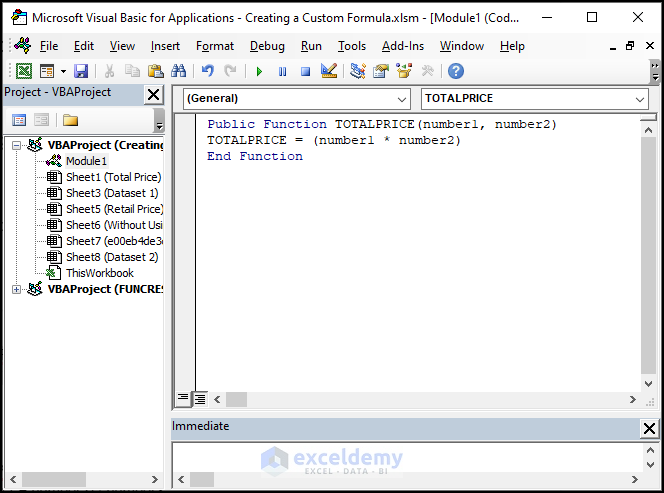
Code Breakdown
- Firstly, we initiate a function named TOTALPRICE.
- We declare the arguments of the function as number1, and number2.
- We specify that the value of TOTALPRICE will be the multiplication of number1 and number2.
- We terminate the function.
- Click on the Save button.
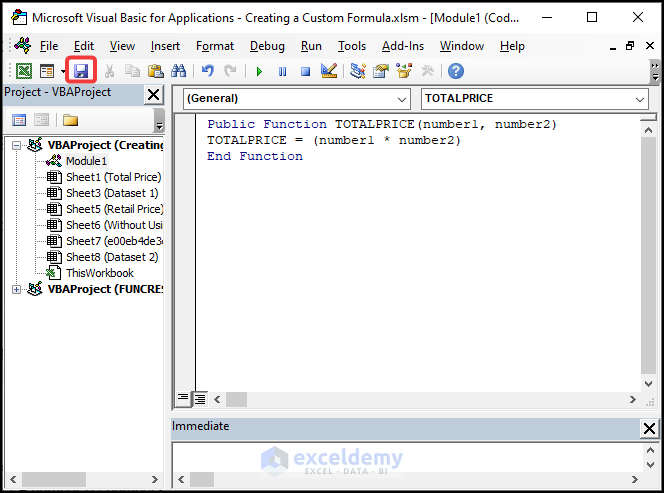
Step 3 – Apply the Custom Formula
After saving the VBA code, we can apply the newly created function.
- Enter the following formula in cell E5:
=TOTALPRICE(C5,D5)Here, cell C5 refers to the first cell of the Stock column, and cell D5 represents the first cell of the Unit Price column.
- Press ENTER.
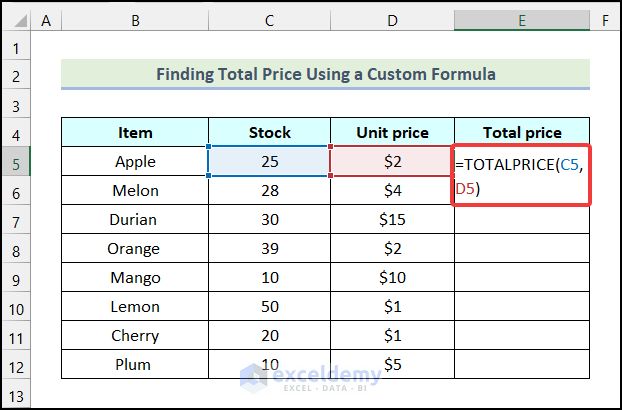
As a result, we have the Total Price for the first Item in cell E5.
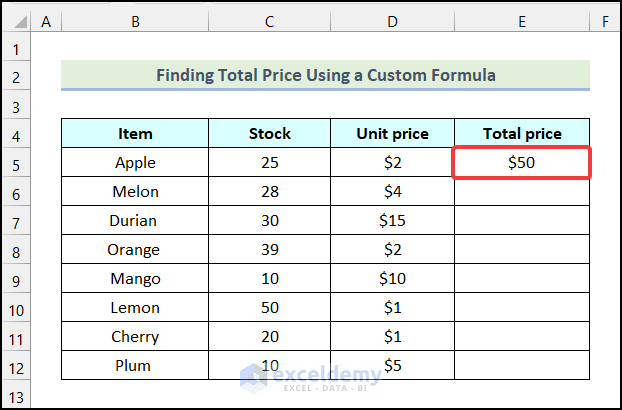
- Use Excel’s AutoFill feature to get the rest of the outputs, as demonstrated in the following picture.
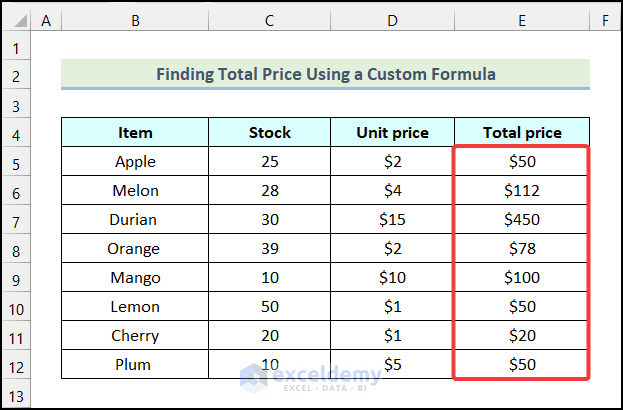
Read More: How to Apply Formula to Entire Column Using Excel VBA
Example 2 – Creating a Custom Formula in Excel for Calculating the Retail Price
Now, let’s consider another example of creating a custom formula in Excel.
Steps:
- Follow the first step of the previous method to open a new Module window.
- Enter the following code in the newly created Module.
Public Function RETAILPRICE(number1, number2, number3)
RETAILPRICE = (number1 + number2) / number3
End Function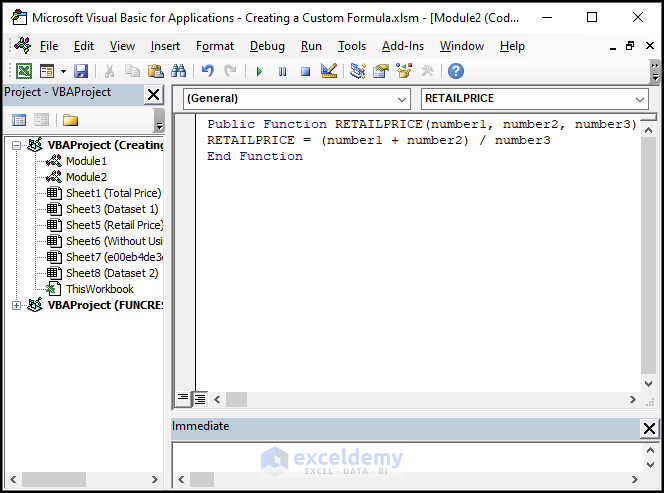
Code Breakdown
- We initiate a function named RETAILPRICE.
- We declare the arguments of the function as number1, number2, and number3.
- We specify the value of TOTALPRICE in terms of number1, number2 and number3.
- We end the function.
- Click on the Save button.
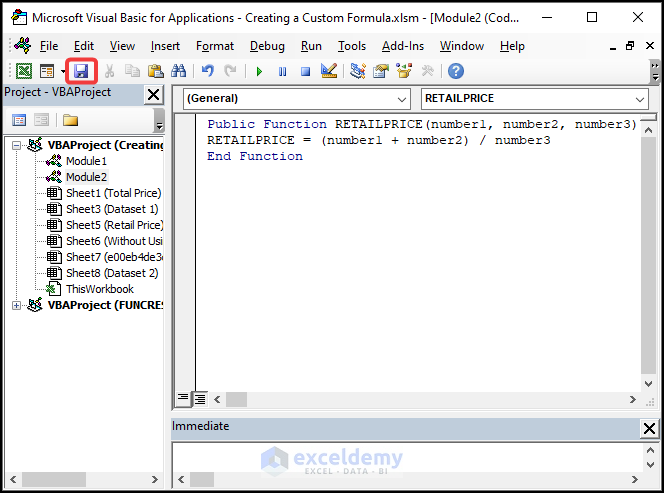
- Apply the formula below in cell F5:
=RETAILPRICE(C5,D5,E5)Here, cell E5 indicates the first cell of the Divisor column.
- Press ENTER.
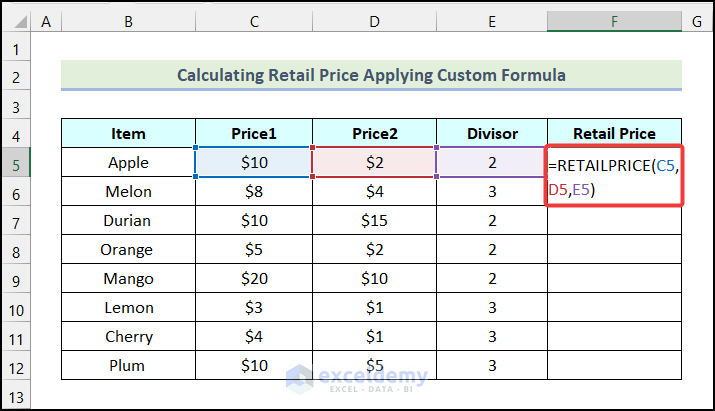
We have the Retail Price for the first Item in cell F5.
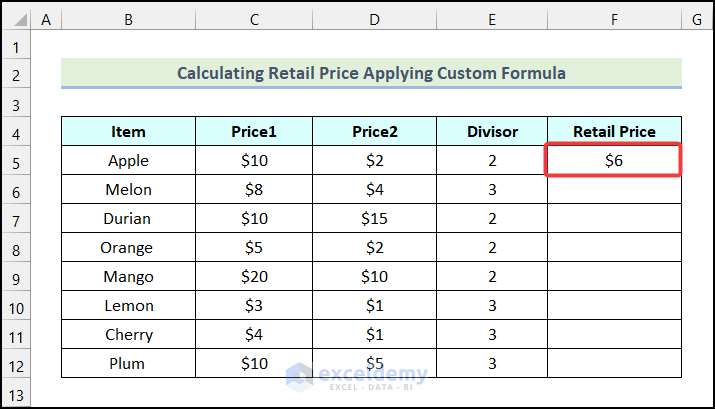
- Use Excel’s AutoFill option to get the Retail Prices for the remaining Items as demonstrated in the image below.
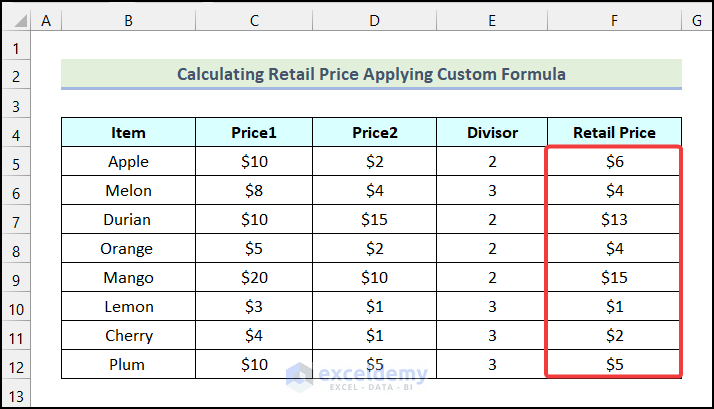
How to Create a Custom Formula Without Using VBA in Excel
We can also create a custom formula without using VBA in Excel with the help of the Lambda Function and the Define Name option.
Consider a situation where we want to calculate the salary of the employees considering increments. We want to create a custom formula where we will define cells containing the salary and increment rate, and the formula will return the current total salary considering the increment.
Steps:
- Go to Define Name from the Formulas tab.
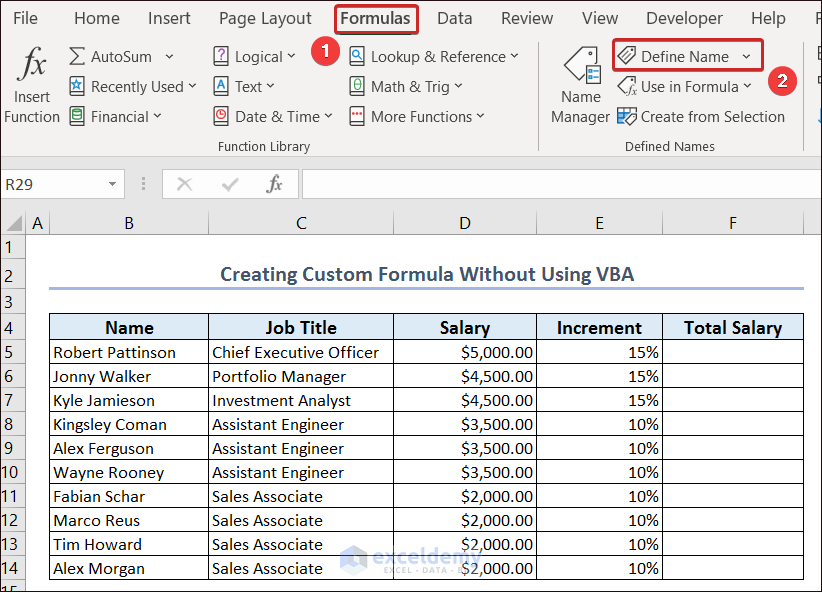
An Edit Name wizard will appear.
- Give a suitable name (i.e. Salary_with_Increment) to the custom formula from the Name section and add a description about the formula in Comment.
- Insert the following formula in the Refers to section:
=LAMBDA(salary,increment_rate,salary*(1+increment_rate))- Click on OK to finish the formula formation process.
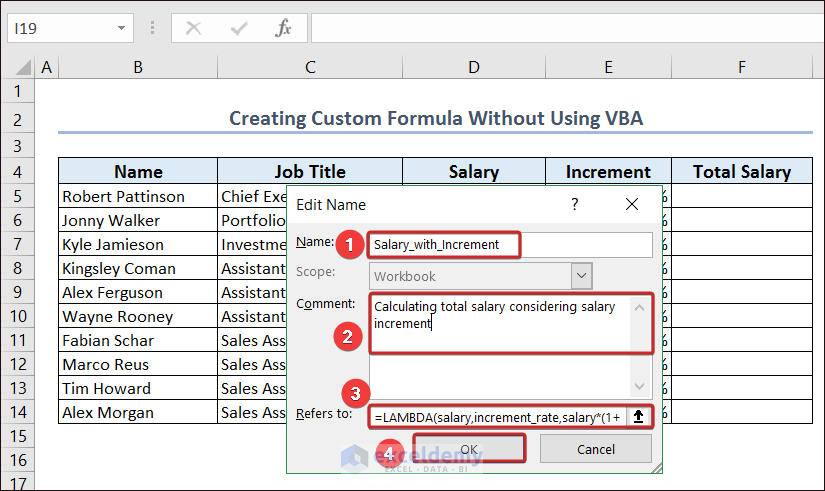
Now, the formula that we made is available for use in the worksheet.

- Apply the following formula to get the total salary considering increment with our custom formula made without VBA:
=Salary_with_Increment(D5,E5)Here,
D5 = Previous Salary
E5 = Increment Rate
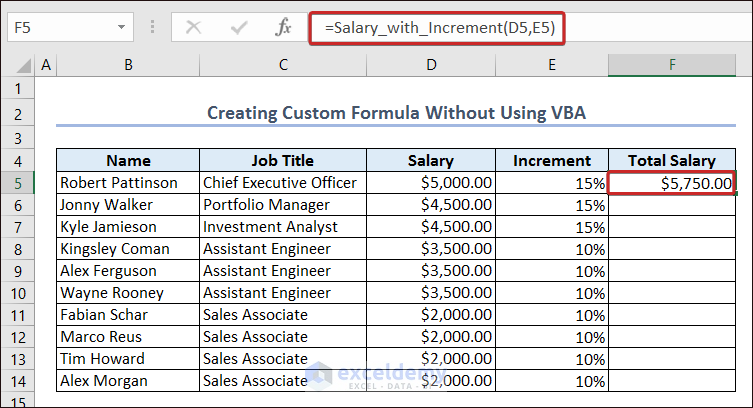
- Use the Fill Handle to AutoFill the custom formula down to the last cell.
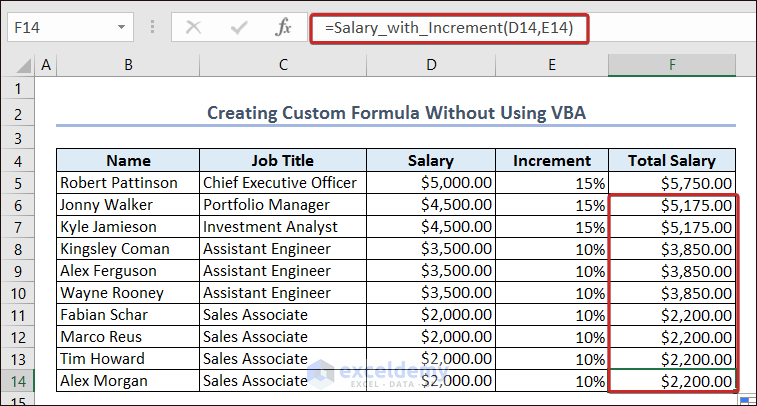
Read More: How to Create a Formula in Excel for Multiple Cells
Quick Notes
- You cannot Record a customized formula like you can an Excel macro.
- Creating a custom formula has more limitations than regular VBA macros. It cannot alter the structure or format of a worksheet or cell.
Similar Articles
- How to Apply Formula in Excel for Alternate Rows
- How to Insert Formula for Entire Column in Excel
- How to Create a Conditional Formula in Excel
- How to Create a Formula Using Defined Names in Excel
- How to Create a Formula in Excel without Using a Function
- How to Create a Complex Formula in Excel
<< Go Back to How to Create Excel Formulas | Excel Formulas | Learn Excel
Get FREE Advanced Excel Exercises with Solutions!


This worked perfectly. However, how can I get excel to show the formula input preview thread below the cell? For example, when I pull up “=RETAILPRICE(” in a cell, I want to see the formula guide that pops up below “RETAILPRICE(Price1,Price2,Divisor)”.
Dear TAYFOON,
Thank you for your response.
If you want to see the arguments as “RETAILPRICE(Price1,Price2,Divisor)”.
Then follow the instructions below-
1) In the module Place the following code-
Public Function RETAILPRICE(Price1, Price2, Divisor) RETAILPRICE = (Price1 + Price2) / Divisor End Function2) Then go to your worksheet and type “=RETAILPRICE(” and after that press Ctrl+Shift+A to get the arguments just as you want.
Hope you found your solution. Thanks!